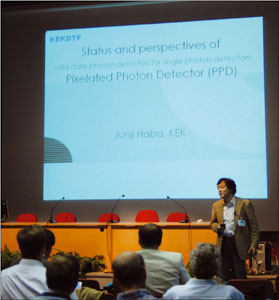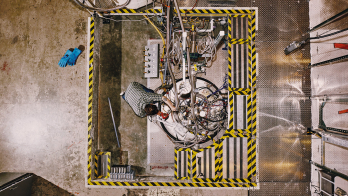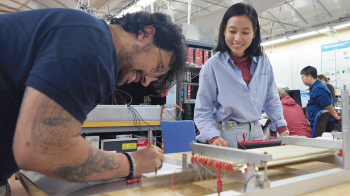An international meeting confirms the vitality of the technique
Ring imaging Cherenkov (RICH) counters provide a unique tool to identify charged particles by measuring their velocity, even when it differs from the velocity of light by only one part in 10 million. The devices detect the visible and UV photons emitted through the Cherenkov effect, measuring the angle of the Cherenkov radiation with an imaging technique, and hence the velocity. This method offers the possibility of measuring particle velocity in domains where others fail, opening the way to particle identification over a wide range of particle momenta. In the current era of high-resolution and high-precision experiments, the domain of applications is becoming even larger, and more challenging requirements for the design of new detectors are arising.

Image credit: INFN.
The 6th International Workshop on Ring Imaging Cherenkov Counters, which took place in Trieste on 15–20 October 2007, covered all of this and more, with experts from around the world to analyse both the state of the art and novel perspectives in the field. Hosted by the Sezione di Trieste of INFN, this was the latest in a series of meetings that have become a reference point in the field of Cherenkov imaging detectors (CERN Courier May 2005 p33). The tradition continued at the Trieste meeting, attracting 120 participants – a quarter coming from outside Europe – with its scientific programme of invited and contributed talks and poster contributions. The workshop also recognized young researchers in the field with the RICH2007–NIM A Young Scientists’ Award, offered by Elsevier for young scientists (under the age of 32) attending the workshop and contributing with a talk or a poster. Nine young people were eligible, and the RICH2007 International Scientific Advisory Committee, chaired by Eugenio Nappi of Bari, awarded the prize to Federica Sozzi, a PhD physics student from the University of Trieste.
From RHIC to DIRC
The workshop provided an opportunity to confirm the central role that RHIC detectors play in particle and nuclear physics, where they form key systems in current and future experiments in a variety of fields: light and heavy quark spectroscopy, K and B physics, nucleon structure, quark–gluon plasma, heavy-ion physics, hadronic matter and hypernuclei. This was evident in the comprehensive review by David Websdale of Imperial College London and in a number of contributions, several dedicated to RICH counters in experiments at CERN, such as the successful upgrade of RICH-1 in COMPASS, the high-momentum particle-identification detector for ALICE and the RICH detectors for LHCb (CERN Courier July/August 2007 p30). In experimental astroparticle physics, RICH detectors are indispensable in balloon and satellite-borne experiments studying the composition of cosmic rays. They also form the complete apparatus in telescopes to detect solar and cosmic neutrinos and in high-energy gamma-ray astronomy, as Eckhart Lorenz of the Max Planck Institute for Physics Munich and ETH Zurich emphasized in his exciting review.
The most innovative approaches in Cherenkov ring imaging techniques that were presented at the meeting centred on concepts derived from the detection of internally reflected Cherenkov light (DIRC) technique. Pioneered in the BaBar experiment at SLAC, this uses quartz as both a radiator and a light guide. Kenji Inami of Nagoya described the time-of-propagation approach, illustrating it with recent results from a test beam. In this technique the measurement of a space co-ordinate is replaced by the high-resolution measurement of a time co-ordinate, resulting in a much smaller photon-detector array. A further development of the DIRC concept is to use fast pixelated photon detectors, which provide high-resolution timing, in order to correct for chromatic dispersion of Cherenkov photons generated in the quartz radiator bars. The focusing-DIRC approach applies this technique and uses a focusing mirror to allow the dispersion of the measured Cherenkov angles generated by the thickness of the quartz bars to be reduced. Jochen Schwiening of SLAC showed how a focusing-DIRC prototype operated in a test beam has demonstrated for the first time the possibility of correcting the chromatic effect, thereby making possible a substantial gain in detector resolution.
The DIRC-derived detectors are largely based on the exceptional time resolution of a few tens of picoseconds that can be obtained with microchannel plate photomultipliers. The characteristics of these photon detectors open the way to other frontier applications, such as the compact time-of-flight detector that Jerry Va’vra of SLAC presented. In the field of vacuum-based photon detectors, which CERN’s Thierry Gys reviewed, traditional photomultipliers can today be produced with a greatly increased quantum efficiency, with peak values more than 40%. Furthermore, hybrid photodetectors, which are vacuum-based detectors where the photoelectrons created are detected in silicon, have become a firm reality, thanks to mass production for the RICH detectors in LHCb.
Innovative approaches
Solid-state and gaseous photon detectors were review topics broached by Junji Haba of KEK and Rachel Chechik of the Weizmann Institute, respectively. The first tests of Cherenkov ring imaging with silicon photomultipliers were reported by Samo Korpar of Ljubljana. In gaseous photon counters, despite the success of the first photon detectors with a solid-state photocathode – namely, multiwire proportional chambers equipped with a layer of caesium iodide as photoconverter – there are problems in exposing a photocathode to a gaseous atmosphere. The bombardment of the photocathode by ions flowing back from the amplification region results in performance limitations. Closed geometries, such as those achieved in multistage micropattern gaseous detectors, represent the new frontier, making possible drastic reductions of the ion backflow down to less than one part in a thousand. The new Cherenkov detector that forms the Hadron Blind Detector of the PHENIX experiment at RHIC at Brookhaven, which has been in operation for several months, is the first counter to follow this innovative approach.
The optimal performance of sophisticated detectors like RICH counters requires excellent technical and technological achievements in a variety of sectors, often achieved using innovative and challenging approaches. This was confirmed by the large number of new developments and ideas discussed at RICH2007. Groups in Novosibirsk and Japan have attained new goals in the production of aerogel, in particular in terms of improved transparency and the production of tiles with a variable refractive index. Optical components in Cherenkov imaging detectors are becoming increasingly important and the requirements now include mirrors, lenses and systems to control and monitor the alignment of huge optical arrangements. The new emphasis on high-resolution time measurements requires extended electronic readout systems to preserve the detector time resolution, such as already in use for the multi-anode photomultiplier tubes of RICH-1 in COMPASS. Sophisticated detector-control systems guarantee optimal performance of the detectors in operation, as in LHCb experiment, for example.
Last but certainly not least, as Guy Wilkinson of Oxford explained, effective algorithms for image-pattern recognition and particle identification are key elements in optimizing the response of Cherenkov imaging counters. Even though the algorithms are applied to different arrangements, there are some common choices: Hough transformations convert the measured quantities into co-ordinates in a space more naturally related to the Cherenkov effect; and likelihood-based algorithms maximize the amount of information extracted from the data.
More exotic applications include the detection of Cherenkov radiation in the radio wavelength region for astroparticle research, as Amy Connoly of University College London discussed. The use of Cherenkov light for calorimetric applications also raised a great deal of interest at the workshop.
In summary, the intense scientific sessions and the numerous talks and contributions at RICH2007 resulted in a picture of great vitality. This was clear from the inspiring introductory talk by Blair Ratcliff of SLAC and in the summary of highlights by Silvia Dalla Torre of Trieste. The participants also benefited from the workshop’s location in the centre of Trieste, directly on a pier, and a social programme that included a visit to the Roman ruins of Aquileia’s river harbour and basilica, a walk through the huge Karst cave Grotta Gigante and a choir recital in Trieste’s cathedral. RICH practitioners already look forward to the next meeting, where appealing host sites have been proposed, such as Marseille and KEK.
• RICH2007 was sponsored by several Italian and other European institutions and private companies. These included INFN, Hadron Physics I3, CERN, the University of Trieste, the Consorzio per la Fisica and Sincrotrone Trieste. For more information, see http://rich2007.ts.infn.it/sponsors.php.








